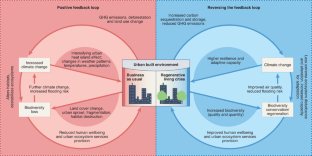The expansion of urban environments contributes to climate change and biodiversity loss. Implementing nature-based strategies to create ‘regenerative living cities’ will be critical for climate change mitigation and adaptation and will produce measurable biodiversity and wellbeing co-benefits.
This is a preview of subscription content, access via your institution
Relevant articles
Open Access articles citing this article.
-
Nature can cool cities, but proceed with caution
Urban Transformations Open Access 21 September 2023
Access options
Access Nature and 54 other Nature Portfolio journals
Get Nature+, our best-value online-access subscription
$29.99 / 30 days
cancel any time
Subscribe to this journal
Receive 12 print issues and online access
$209.00 per year
only $17.42 per issue
Buy this article
- Purchase on Springer Link
- Instant access to full article PDF
Prices may be subject to local taxes which are calculated during checkout


Tuul & Bruno Morandi/The Image Bank/Getty
References
CIAT Global Rural-Urban Mapping Project, v1 (GRUMPv1): Urban Extents Grid (NASA SEDAC, 2011).
Global Status Report for Buildings and Construction: Towards a Zero-Emission, Efficient and Resilient Buildings and Construction Sector (UNEP, 2020).
Harris, N. L. et al. Nat. Clim. Change 11, 234–240 (2021).
Reid, W. V. et al. Ecosystems and Human Well-being: Biodiversity Synthesis (Millenium Ecosystem Assessment, World Resources Institute, 2005).
Xu, C. et al. Resour. Conserv. Recycl. 151, 104478 (2019).
Su, J., Friess, D. A. & Gasparatos, A. Nat. Commun. 12, 5050 (2021).
van den Berg, M. et al. Urban For. Urban Green. 14, 806–816 (2015).
Aerts, R., Honnay, O. & Van Nieuwenhuyse, A. Br. Med. Bull. 127, 5–22 (2018).
Lindenmayer, D. et al. Ecol. Lett. 11, 78–91 (2008).
Knapp, S., Jaganmohan, M. & Schwarz, N. in Atlas of Ecosystem Services: Drivers, Risks, and Societal Responses (eds Schröter, M. et al.) 167–172 (Springer, 2019).
Kim, H. Y. Geomat. Nat. Hazards Risk 12, 1181–1194 (2021).
Vargas-Hernández, J. G., Pallagst, K. & Zdunek-Wielgołaska, J. in Handbook of Engaged Sustainability (ed. Marques, J.) 885–916 (Springer, 2018).
Manso, M. et al. Renew. Sustain. Energy Rev. 135, 110111 (2021).
Assimakopoulos, M.-N. et al. Sustainability 12, 3772 (2020).
Mora-Melià, D. et al. Sustainability 10, 1130 (2018).
IPBES. Curr. Opin. Environ. Sustain. 26, 7–16 (2017).
Schröpfer, T. & Menz, S. in Dense and Green Building Typologies: Research, Policy and Practice Perspectives (eds Schröpfer, T. & Menz, S.) 1–4 (Springer, 2019).
Pedersen Zari, M. & Hecht, K. Biomimetics 5, 18 (2020).
Acknowledgements
This work is supported by the NUWAO (Nature-based Urban design for Wellbeing and Adaptation in Oceania) project, funded by a Marsden grant from the Royal Society of New Zealand (www.nuwao.org.nz). Additional support was provided by the Restoring Urban Nature Project funded by an Aotearoa New Zealand Ministry of Business, Innovation and Employment Endeavour grant. The views expressed herein are the authors’ own.
Author information
Authors and Affiliations
Contributions
M.P.Z. conceived the concept for this Comment and led the project coordination. K.V. conceived of the graphics. All authors contributed to the research, writing and revising and editing the manuscript.
Corresponding author
Ethics declarations
Competing interests
The authors declare no competing interests.
Rights and permissions
About this article
Cite this article
Pedersen Zari, M., MacKinnon, M., Varshney, K. et al. Regenerative living cities and the urban climate–biodiversity–wellbeing nexus. Nat. Clim. Chang. 12, 601–604 (2022). https://doi.org/10.1038/s41558-022-01390-w
Published:
Issue Date:
DOI: https://doi.org/10.1038/s41558-022-01390-w
This article is cited by
-
Nature can cool cities, but proceed with caution
Urban Transformations (2023)
-
Global mapping of urban nature-based solutions for climate change adaptation
Nature Sustainability (2023)
